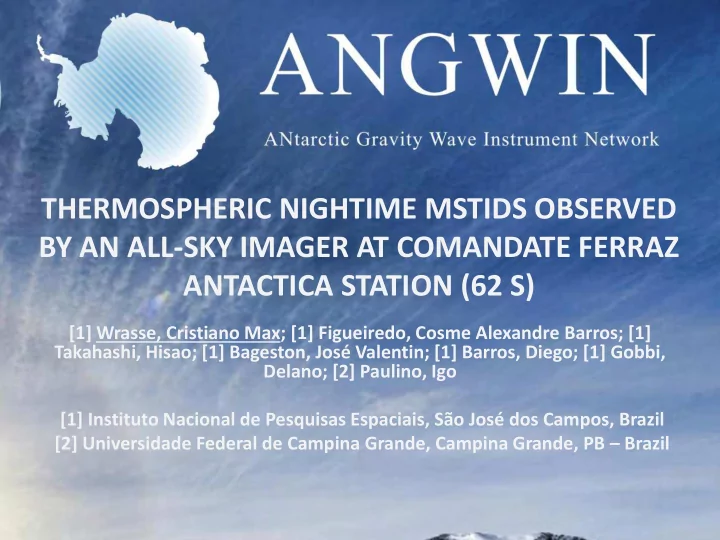

THERMOSPHERIC NIGHTIME MSTIDS OBSERVED BY AN ALL-SKY IMAGER AT COMANDATE FERRAZ ANTACTICA STATION (62 S) [1] Wrasse, Cristiano Max; [1] Figueiredo, Cosme Alexandre Barros; [1] Takahashi, Hisao; [1] Bageston, José Valentin; [1] Barros, Diego; [1] Gobbi, Delano; [2] Paulino, Igo [1] Instituto Nacional de Pesquisas Espaciais, São José dos Campos, Brazil [2] Universidade Federal de Campina Grande, Campina Grande, PB – Brazil
Outline Ferraz station at King George Island All-Sky airglow imager Wave Activity over Ferraz Station Summary 2
3
Partial view of King George Island, that is located about 200 km North of the Antarctic Peninsula (62.1°S, 58.4°W) 4 Source: 1º Helicopter Squadron for General Employment (Esqd HU-1), Brazilian Navy
Source: 1º Helicopter Squadron for General Employment (Esqd HU-1), Brazilian Navy Punta Plaza facility (meteor radar and All-Sky camera) 5
Ferraz Station - Punta Plaza Site Source: J. V. Bageston
Observing Gravity Waves at Ferraz A new all-sky airglow imager with three filters (OH NIR, OI 557.7 and 630.0 nm) was installed at Ferraz Antarctic Station in 2014.
Wave Activity in Mesophere Region 8
Wave Activity in Mesophere Region 9
Wave Activity in Ionosphere Region 10
Wave Activity in Ionosphere Region 11
Are these waves related to OH emission? OI Filter used has a Band Wide of 20 Å OH(9-3) 12
How to ruled out OH Contamination? So, no wave was propagating at the mesosphere to NW direction! 13
We used the well know How to obtained OI 6300 wave parameters? Cross Spectrum Analysis Horizontal Wavelength h ~ 100 km obs ~ 30 min C obs ~ 50 m/s ~ NW Observed Phase Velocity Observed Period Prop. Direction 14
Now we applied the method to all observed cases! 15
Over all Results 27 waves obs ~ 10-50 min h ~75-200 km c obs ~ 75-175 m/s NW S 16
So, what kind of waves are they? When wave structures are observed in the ionospheric parameters, they are called traveling ionospheric disturbances (TIDs). Depending on the size of the TID, they can be called small scale (SSTID), medium scale (MSTID) or large scale (LSTID). Type Period (min) Wavelength (km) Phase Velocity (m/s) 100 km c 200 m/s SSTID Few minutes 5 60 minutes 1500 km 100 c 700 m/s MSTID 30 min ~hours > 1000 km 300 c 1200 m/s LSTID 17
Comparison with other OI 630 nm observations 18
62 o S 22 o S 7 o S (27 waves) (48 waves) (98 waves) h ~ 90-140 km h ~ 100-200 km h ~ 75-200 km Figueiredo et al, 2018 (submited JGR) Paulino et al., 2016 obs ~ 10-30 min obs ~ 10-35 min Present Results obs ~ 10-50 min c h ~ 80-150 m/s c h ~ 30-180 m/s c h ~ 75-175 m/s 2 years 2.5 years 10 years 19
Propagation Direction 62 o S 22 o S 7 o S (48 waves) (98 waves) (27 waves) One of the most important mechanisms that has been pointed out as being effective for generation of MSTIDs is the Perkins instability (Perkins, 1973). 20
TID’s Propagation Direction Perkins instability Mechanism NH SW Equator NW SH 21
Looking closely in the wave Propagation Directions 22
7 o S Paulino et al., 2016 (98 waves) -Not related with the Perkins instability process. -Not directed linked by waves generated in the troposphere. -Waves may be generated at the bottom site of the ionosphere region (FRITTS et al., 2009) 23
22 o S Figueiredo et al., 2018 (Submitted to JGR) (48 waves) Cloud Top Brightness Temperature (CTBT) with temperatures below -45°C. Winter Cold front and tropospheric jet stream 24
62 o S (27 waves) SSGW MSGW Perkins Instability Mechanism NH SW Equator NW SH 25
Summary Around 27 MSTIDs were observed in 2 years (2015 e 2016) at the Brazilian Antarctic Station; The main MSTID’ s characteristics: h ~ 75 - 200 km obs ~ 10 - 50 min c obs ~ 75 - 175 m/s Similar wave parameters were found at S.J. Cariri (7 o S) and Cachoeira Paulista (22 o S); According to MSTID’s propagation direction they seem be generated by the Perkins Instability Mechanism, however more investigation should be done.
Obrigado! Perguntas?
Recommend
More recommend